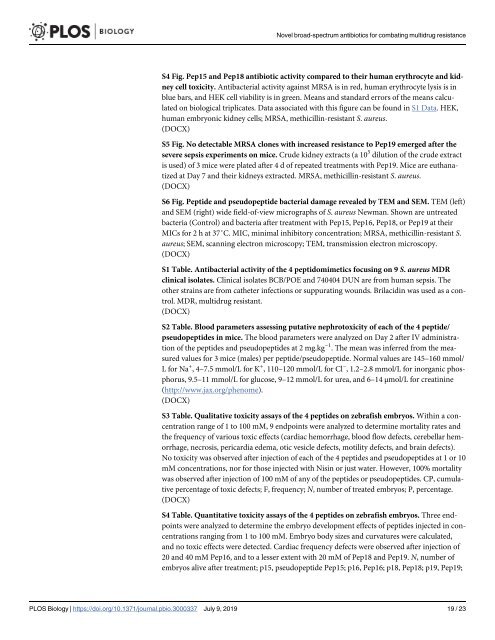Novel antibiotics effective against grampositive and -negative multi-resistant bacteria with limited resistance
Antibiotics are a medical wonder, but an increasing frequency of resistance among most human pathogens is rendering them ineffective. If this trend continues, the consequences for public health and for the general community could be catastrophic. The current clinical pipeline, however, is very limited and is dominated by derivatives of established classes, the “me too” compounds.
Antibiotics are a medical wonder, but an increasing frequency of resistance among most human pathogens is rendering them ineffective. If this trend continues, the consequences for public health and for the general community could be catastrophic. The current clinical pipeline, however, is very limited and is dominated by derivatives of established classes, the “me too” compounds.
Create successful ePaper yourself
Turn your PDF publications into a flip-book with our unique Google optimized e-Paper software.
<strong>Novel</strong> broad-spectrum <strong>antibiotics</strong> for combating <strong>multi</strong>drug <strong>resistance</strong><br />
S4 Fig. Pep15 <strong>and</strong> Pep18 antibiotic activity compared to their human erythrocyte <strong>and</strong> kidney<br />
cell toxicity. Anti<strong>bacteria</strong>l activity <strong>against</strong> MRSA is in red, human erythrocyte lysis is in<br />
blue bars, <strong>and</strong> HEK cell viability is in green. Means <strong>and</strong> st<strong>and</strong>ard errors of the means calculated<br />
on biological triplicates. Data associated <strong>with</strong> this figure can be found in S1 Data. HEK,<br />
human embryonic kidney cells; MRSA, methicillin-<strong>resistant</strong>S.aureus.<br />
(DOCX)<br />
S5 Fig. No detectable MRSA clones <strong>with</strong> increased <strong>resistance</strong> to Pep19 emerged after the<br />
severe sepsis experiments on mice. Crude kidney extracts (a 10 5 dilution of the crude extract<br />
is used) of 3 mice were plated after 4 d of repeated treatments <strong>with</strong> Pep19. Mice are euthanatized<br />
at Day 7 <strong>and</strong> their kidneys extracted. MRSA, methicillin-<strong>resistant</strong>S.aureus.<br />
(DOCX)<br />
S6 Fig. Peptide <strong>and</strong> pseudopeptide <strong>bacteria</strong>l damage revealed by TEM <strong>and</strong> SEM. TEM (left)<br />
<strong>and</strong> SEM (right) wide field-of-view micrographs ofS.aureus Newman. Shown are untreated<br />
<strong>bacteria</strong> (Control) <strong>and</strong> <strong>bacteria</strong> after treatment <strong>with</strong> Pep15, Pep16, Pep18, or Pep19 at their<br />
MICs for 2 h at 37˚C. MIC, minimal inhibitory concentration; MRSA, methicillin-<strong>resistant</strong>S.<br />
aureus; SEM, scanning electron microscopy; TEM, transmission electron microscopy.<br />
(DOCX)<br />
S1 Table. Anti<strong>bacteria</strong>l activity of the 4 peptidomimetics focusing on 9S.aureus MDR<br />
clinical isolates. Clinical isolates BCB/POE <strong>and</strong> 740404 DUN are from human sepsis. The<br />
other strains are from catheter infections or suppurating wounds. Brilacidin was used as a control.<br />
MDR, <strong>multi</strong>drug <strong>resistant</strong>.<br />
(DOCX)<br />
S2 Table. Blood parameters assessing putative nephrotoxicity of each of the 4 peptide/<br />
pseudopeptides in mice. The blood parameters were analyzed on Day 2 after IV administration<br />
of the peptides <strong>and</strong> pseudopeptides at 2 mg.kg −1 . The mean was inferred from the measured<br />
values for 3 mice (males) per peptide/pseudopeptide. Normal values are 145–160 mmol/<br />
L for Na + , 4–7.5 mmol/L for K + , 110–120 mmol/L for Cl − , 1.2–2.8 mmol/L for inorganic phosphorus,<br />
9.5–11 mmol/L for glucose, 9–12 mmol/L for urea, <strong>and</strong> 6–14μmol/L for creatinine<br />
(http://www.jax.org/phenome).<br />
(DOCX)<br />
S3 Table. Qualitative toxicity assays of the 4 peptides on zebrafish embryos. Within a concentration<br />
range of 1 to 100 mM, 9 endpoints were analyzed to determine mortality rates <strong>and</strong><br />
the frequency of various toxic effects (cardiac hemorrhage, blood flow defects, cerebellar hemorrhage,<br />
necrosis, pericardia edema, otic vesicle defects, motility defects, <strong>and</strong> brain defects).<br />
No toxicity was observed after injection of each of the 4 peptides <strong>and</strong> pseudopeptides at 1 or 10<br />
mM concentrations, nor for those injected <strong>with</strong> Nisin or just water. However, 100% mortality<br />
was observed after injection of 100 mM of any of the peptides or pseudopeptides. CP, cumulative<br />
percentage of toxic defects; F, frequency;N, number of treated embryos; P, percentage.<br />
(DOCX)<br />
S4 Table. Quantitative toxicity assays of the 4 peptides on zebrafish embryos. Three endpoints<br />
were analyzed to determine the embryo development effects of peptides injected in concentrations<br />
ranging from 1 to 100 mM. Embryo body sizes <strong>and</strong> curvatures were calculated,<br />
<strong>and</strong> no toxic effects were detected. Cardiac frequency defects were observed after injection of<br />
20 <strong>and</strong> 40 mM Pep16, <strong>and</strong> to a lesser extent <strong>with</strong> 20 mM of Pep18 <strong>and</strong> Pep19.N, number of<br />
embryos alive after treatment; p15, pseudopeptide Pep15; p16, Pep16; p18, Pep18; p19, Pep19;<br />
PLOS Biology | https://doi.org/10.1371/journal.pbio.3000337 July 9, 2019 19 / 23


















